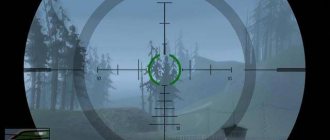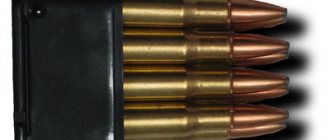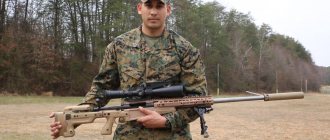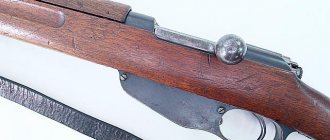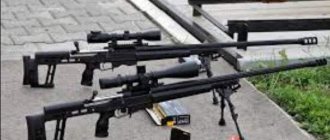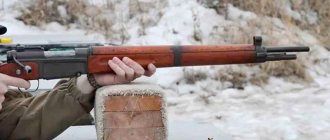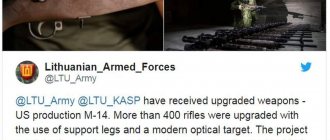Murata rifle: from the first samples to a rifle with a middle magazine
Initially, Japan, whose industrial development after the Meiji Revolution was catching up, was forced to purchase rifles from European countries, until in 1880 it adopted its own single-shot Murata rifle chambered for black powder. The further evolution of Japanese small arms followed the already beaten path of Europe - the transformation of a single-shot model into a repeating rifle. Thus, the Murat rifle received an eight-round under-barrel magazine. As a temporary measure, this was completely justified both militarily and economically. It was easier and cheaper to modernize an existing model than to create a new one in conditions of very rapid aging of small arms.
The Murata rifle became the main weapon of the Japanese army in the war with China in 1894-1895. Meanwhile, a number of armies around the world began to adopt models with a middle magazine, which was filled using a clip or a pack. In this direction, further modernization of the Murata rifle was not justified - the adoption of a fundamentally new model was required. And such a weapon was the Arisaka rifle of the 1897 model.
Bayonets
Type 30
Created at the same time as the Type 30 rifle, this bayonet-type sword is compatible with all variants of the Arisaka rifle except for the Type 44. There are twenty different options, and are further classified into early, middle and late war production stages. Also fixed on Type 96 and light machine guns.
Type 35 bayonet
The Type 35 bayonet was a slightly modified 30 bayonet type, specifically designed for the Type 35 rifle. The dimensions of the bayonet are almost exactly the same as the Type 30 bayonet. The only real difference between the two is the added addition of a sprung catch that hooks into the sheath when not in use.
About 8,400,000 were made.
Type 44
Fixed permanently on Type 44 carbines, this bayonet-type stud folds under the forend and does not interfere with the barrel when deployed.
Type 2
Since the long length of the TYPE 30 is unsuitable for concealment in a paratrooper's set of personal equipment, this bayonet-type knife was created to solve this problem. Twenty centimeters shorter than the Type 30, its overall length is 32.3 cm. Used primarily with the Type 2 TERA rifle or Type 100 submachine gun by Imperial Military Airborne departments.
About 25 thousand were made.
Features of the Arisaka rifle
The creator of the rifle, whose name it received, was the colonel, and later also the general, Nariake Arisaka. Along with Italy, Japan adopted the rifle chambered for a reduced caliber - only 6.5 mm. The military, as a rule, was distrustful of the reduction in caliber, but on the battlefield the 6.5 mm cartridge was quite enough to destroy manpower. At the same time, there were a number of noticeable advantages - relatively low recoil when firing and, accordingly, a smaller mass of portable ammunition with an equal number of cartridges. In addition, the weapon was distinguished by high shooting accuracy.
The creator of the rifle is Colonel Arisaka. (Pinterest)
The Arisaka rifle had a clip-on loading system with a staggered arrangement of cartridges in the magazine. In case of hand-to-hand combat, the weapon was equipped with a very impressive blade-type bayonet. Taking into account the Russo-Japanese War, where a number of shortcomings were revealed, some changes were made to the design of the rifle. First of all, the sights and rifle bolt underwent modernization. In addition, in 1906, the Japanese army switched to using a new cartridge with a pointed bullet.
Subsequently, the Arisaka rifle was modernized several times. A description of all types of rifles and carbines created on its basis may be the topic of a separate study. Let us only note that the fundamental difference between the rifles produced since the late 1930s was the transition to a new 7.7 mm caliber. This rifle was produced in several versions, differing in length and scope. Carbines differed from rifles in length and, in some cases, in the presence of a folding needle bayonet. The total production of Arisaka rifles amounted to about 3.5 million units - this is relatively little and indicates that the weapon was produced primarily for the needs of its own army. At the same time, the main losses of small arms for Japan occurred during the Second World War and there was no need to produce rifles in tens of millions.
Options and modifications[edit]
Type 30 training rifle[edit]
In 1905-1921. jabout 10,000 rifles were converted to fire blank cartridges. The rifled barrel of the weapon was counterbored to make the barrel smooth, and most of the markings on the receiver were removed, including the Imperial Chrysanthemum. In its place were the symbols 空放銃, which means “For firing blanks.”
Type 35 naval rifle[edit]
Type 35 rifle
- modification of the Type 30 rifle, made in 1902 by order of the Japanese Imperial Navy. The Type 35 featured a new sector sight and a long barrel guard. The rifle was equipped with a removable lid that covered the receiver window in the stowed position. During shooting, the cover was removed. Before the advent of the Type 38 rifle, it was in service with the amphibious brigade. Length 1273 mm. Weight without cartridges 4.2 kg. Barrel length 797 mm.
Type 30 Cavalry Carbine[edit]
Type 30 Cavalry Carbine
- a modified version for cavalry, shorter by 300 millimeters than the infantry model (carbine barrel length is 480 mm versus 790 mm for a standard rifle). Designed to equip cavalry troops with a modern carbine. The differences, other than a shorter barrel and stock from the standard infantry rifle, are that it did not have a barrel guard, the effective range was limited to 1,500 meters (compared to 2,000 meters for the standard rifle), the front sight had protective guards on each side, minor changes to the bolt release latch, the swivel was moved to the left side of the weapon so that it does not rest against the cavalryman's back. The pre-production version did not have a bayonet.
"Manchurian Arisaka"[edit]
The Manchurian Arisaka is a Type 30 rifle supplied to China. Collectors call them "Manchurian Arisaka"; actual military designation in China is unknown. It is known that there are two versions and they are named after the markings on the receiver, which are made in Chinese - Guangxu (the last emperor of the Qing dynasty) 29 years old and Guangxu 31 years old. Instead of the imperial chrysanthemum applied to rifles for the Japanese army, the Chinese version had a curled dragon, which was a symbol of the Manchu dynasty. Even though the rifle had Guangxu's name on it, the real person behind the contract to supply these rifles from Japan was General Yuan Shikai. Little is known about these rifles, other than that few of the 31,000 rifles survive today, and most were imported into the United States from mainland China in the 1980s in very deteriorated condition.
North Chinese copy of the Type 30 carbine[edit]
A relatively crude copy of the Japanese Type 30 carbine was produced in China to arm the troops of pro-Japanese puppet governments. It is believed that the production of rifles took place in the city of Tianjin. The main difference between the Chinese and Japanese version of the Type 30 is that the copy is chambered for the 7.92×57mm Mauser cartridge and the stock is made in one piece, while the Japanese model has a two-piece stock. The receiver features a cherry blossom instead of the usual Japanese chrysanthemum, and also features the Japanese symbols 北支一九式, which translates to “North China Type 19.” 19 could mean the 19th year of the Showa era or 1944. The true military designation is unknown. Supposedly there is another "North China Type 19" based on the Type 38.
In Russian service: from the First to the Second World War
In the Russian Empire during the First World War, the army from the very beginning experienced an acute shortage of weapons. This also affected rifles. Since in 1914 domestic enterprises could not quickly make up for the huge loss of small arms on the battlefields, a decision was made to purchase foreign models from the USA, France and Japan. Some of these weapons were obsolete and were sent to the rear units.
Russian soldiers with an Arisaka rifle. (Pinterest)
Rifles of both the 1905 model and the 1897 model were supplied from Japan. The Japanese got rid of obsolete and worn-out rifles of the 1897 model quite cheaply. Since the purchase of cartridges was intermittent, it was decided to establish its own production of 6.5 mm cartridges at the Petrograd Armory factory The production of 200 thousand units per month did not cover the entire consumption of ammunition, but together with purchases in Japan and England, it even made it possible to create some reserves by 1917. In total, at least 750 thousand Arisaka rifles entered the Russian army and navy. Moreover, most of the Japanese rifles ended up in the troops of the Northern Front. The Japanese army itself, whose actions in the First World War were very limited, did not lack weapons.
Under the Japanese cartridge of the Arisaka rifle, the famous Fedorov assault rifle was also designed during the First World War. After the end of the Civil War, a significant number of Japanese rifles remained in Soviet Russia, which for some time were still found in the army and territorial units. Subsequently, due to the unification of weapons and the lack of a significant number of cartridges, these weapons ended up in warehouses, and then found themselves in demand during the Great Patriotic War. Relatively few Arisaka rifles were used by militias and fighter battalion personnel. True, this time the crisis with small arms turned out to be short-lived; by 1942, the Arisaka rifle was seen on the Soviet-German front and in the rear less and less often.
History of creation
The war revealed numerous shortcomings in the Arisaka 1897 rifle. It turned out that during the war, the Manchurian dusty winds caused a lot of dust and contaminated the shutter mechanism; In order for the rifle to function smoothly, it was necessary to frequently disassemble and clean the bolt. The sighting frame often became confused and deformed. It turned out to be inconvenient to operate the fuse by grasping it by the hook, especially when acting in a hurry. Disassembling and reassembling the bolt was difficult. There were demands to strengthen the ejector and feed spring, as well as to prevent the loss of the magazine box cover. The Japanese decided to immediately eliminate the noticed shortcomings.
Captured rifles
In addition to deliveries to the First World War, another category of Arisaka rifles that ended up in Russia and the USSR was captured weapons. If the events at Khasan in 1938 did not bring the Red Army significant trophies, then a year later 5,380 Japanese rifles were taken at Khalkhin Gol. The Soviet-Japanese War brought even more trophies, when in August-September 1945 a huge amount of small arms was received. The Red Army no longer needed Japanese rifles in 1945 - the age of repeating rifles was coming to an end. Therefore, a significant mass of captured weapons was transferred to the communist forces of China and found use during the civil war of 1946-1950.
Red Army soldiers with Arisaka rifles. (Pinterest)
In Russian fiction, the Arisaka rifle and carbine are found in a number of books, the plot of which is related to the events of the Civil War and, less commonly, the Soviet-Japanese War. The rifle itself can be found in large museum collections.
Notes
- (unavailable link). MilitaryRifles.com
(August 28, 2008). Retrieved July 19, 2009. - ↑
- ↑ Honeycutt & Anthony p. 8
- Honeycutt & Anthony p. 16
- ↑ Kowner, Rotem (English) Russian.
Historical Dictionary of the Russo-Japanese War (English). - Scarecrow, 2006. - ISBN 0-8108-4927-5. p. 247. - Affairs in the Philippine Islands. Hearings before the Committee. - 1902. - P. 1687.
- (PDF). Philrights.org
. Retrieved March 12, 2020. - . Thedailyguardian.net
(18 October 2013). Retrieved March 12, 2020. (inaccessible link) - . Visayandailystar.com
. Retrieved March 12, 2020. - . Visayandailystar.com
. Retrieved March 12, 2020. - ↑ Westwood, David
. ABC-CLIO (March 12, 2019). Retrieved March 12, 2020. - Chinese Warlord Armies 1911-30
by Philip Jowett, page 22. - Jowett, Philip S.
Rays of the rising sun: armed forces of Japan's Asian allies, 1931-45 (English). - Helion, 2010. - Vol. 1, China & Manchukuo. - P. 15. - ISBN 9781906033781.
Murata rifle
Japanese service rifle Murata rifle Type 22 Murata repeating rifleTypeBolt action service riflePlace of originEmpire of JapanService historyIn service1885–1918Used bySee UsersWarsDonghak Peasant RevolutionFirst Sino-Japanese WarBoxer RebellionRusso-Japanese WarWorld War ISiberian InterventionProduction historyDesigned1880Produced1885–1905VariantsType 13Type 16 Type 18Type 22Type 22 carbineCivilianSpecificationsMass4.09kgLength1294mmBarrel length840mmCartridge11×60mmR Murata8×53mmR MurataCaliber11mm8mmActionBolt actionMuzzle velocity435m/sFeed systemSingle-shot(Type 13, Type 16, Type 18, and civilian models)Repeating rifle 8-round tube magazine (Type 22 rifle), 5-round tube magazine (Type 22 carbine)
The Murata rifle
(村田銃,
Murata jū
) was the first indigenously produced Japanese service rifle adopted in 1880 as the
Meiji Type 13 Murata single-shot rifle
.
The 13
referred to the adoption date, the year 13 in the Meiji period according to the Japanese calendar.
Development
The development of the weapon was lengthy as it involved the establishment of an adequate industrial structure to support it.
Before producing local weapons, the early Imperial Japanese Army had been relying on various imports since the time of the Boshin War, and especially on the French Chassepot, the British Snider-Enfield and the Spencer repeating rifle.
This was about 300 years after Japan developed its first guns, derived from Portuguese matchlock designs, the Tanegashima or “Nanban guns”.
The combat experience of the Boshin War emphasized the need for a standardized design, and the Japanese Army was impressed with the metallic-cartridge design of the French Gras rifle.
The design was invented by Major Murata Tsuneyoshi, an infantry major in the Imperial Japanese Army who had survived the Boshin War and subsequently traveled to Europe.
Adopted in Emperor Meiji's thirteenth year of reign, the rifle was designated as the model 13 and went into production as the 11-millimeter Type 13 single-shot, bolt-action rifle in 1880. The original 11-millimeter Murata cartridge used an approximately 6 -millimeter Boxer-type primer.
Further modifications in the same year involving both tubular and box magazines led to the Type 22 rifle, which was used a tubular magazine and was reduced to caliber 8mm.
The Type 22 was the first Japanese military rifle to utilize smokeless powder and entered military service in 1889.
Three models of bayonets were produced for the rifles: Type 13 and Type 18 which were used with the single-shot variants and Type 22 which were compatible with the repeater variants.
